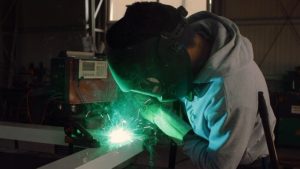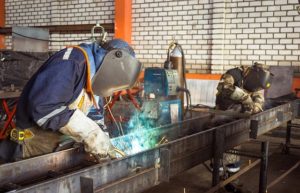TIG Welding Machines are welding equipment that uses inert gas to create a strong weld. They also allow for the welder to control the heat and movement of the arc. This article will discuss what TIG stands for, how it is used, and who often uses it.
What Is TIG Welding?
 TIG welding, or more accurately “inert tungsten gas” (TIG) welding, is a process that uses an electric arc to heat materials and melt them together. It requires non-consumable tungsten electrodes for this purpose because they can withstand high temperatures without melting away. They also ensure that the heat is distributed evenly, which is integral to welding metals. The two most common types of TIG welders are AC, or alternating current, and DC, direct current.
TIG welding, or more accurately “inert tungsten gas” (TIG) welding, is a process that uses an electric arc to heat materials and melt them together. It requires non-consumable tungsten electrodes for this purpose because they can withstand high temperatures without melting away. They also ensure that the heat is distributed evenly, which is integral to welding metals. The two most common types of TIG welders are AC, or alternating current, and DC, direct current.
AC TIG welders use a non-center grounded transformer with an input ranging between 20 – 200 amps at 50 – 60 Hz frequency. This creates an electric arc between the electrode and workpiece, generating a high-temperature plasma.
Advantages of TIG Welding
TIG welding machines are versatile and can be used for metal fabrication, repair work, or even art pieces. They do not produce harmful fumes, making them perfect to use in enclosed spaces without proper ventilation. For anyone new to TIG welding, using a machine will help with accuracy while also maximizing productivity – you don’t have to stop and readjust the machine. This makes it easier to define edges because there is no distortion in the metal. TIG welding machines are also the primary choice for aluminum, stainless steel, and magnesium. These metals require very little heat input, making them perfect for nearly anyone with this type of machine.
Disadvantages of TIG Welding
 The major disadvantage is the lack of portability. They are heavier and oversized, which makes them difficult to transport from one place to another. The cords for this machine can also be cumbersome when it comes time to move or store them in a small space, such as a workshop, a garage, or a basement. This is why they are often used in industry but not as common for home use.
The major disadvantage is the lack of portability. They are heavier and oversized, which makes them difficult to transport from one place to another. The cords for this machine can also be cumbersome when it comes time to move or store them in a small space, such as a workshop, a garage, or a basement. This is why they are often used in industry but not as common for home use.
This type of machine also has a high cost because of all the materials and components that make them up. They can be costly to purchase, especially if you’re looking at more than one machine, such as an AC/DC machine, AC only, and DC only.
The TIG welding process has been around for over a century and has improved by advancements in technology. There are many different types of TIG welders available on the market that use various technologies to produce better results than ever before. With so many options out there, it can be hard to know which one is best suited for your needs. Luckily, we have put together this guide outlining all you need to know about TIG welding machines from their history through how they work and what type will suit your specific job requirements best!


